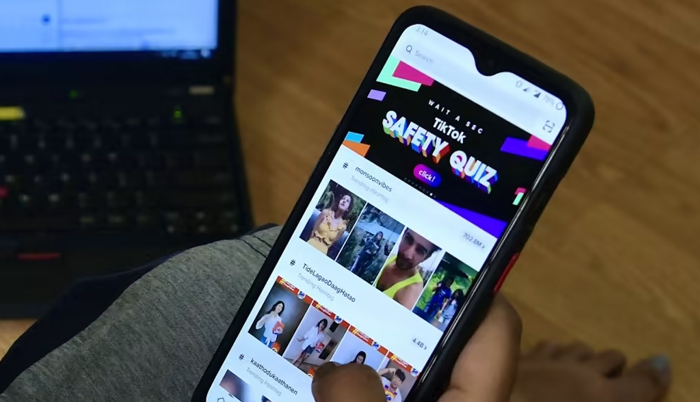![]() Home > Singapore
Home > Singapore
Explainer: Why Do Hoax Social Media Challenges Go Viral And How To Avoid Falling Prey To Them?

Explainer: Why do hoax social media challenges go viral and how to avoid falling prey to them?AFP
![]() July 15th, 2023 | 09:11 AM |
July 15th, 2023 | 09:11 AM | ![]() 304 views
304 views
SINGAPORE
News of a dangerous “boat jumping” TikTok challenge spread like wildfire earlier this month on international news outlets when the captain of a rescue team in Alabama told his local television station that the supposedly viral challenge had claimed four lives in the past six months.
This supposed “boat jumping” TikTok challenge involved its participants leaping off speedboats travelling at high speeds, which resulted in several deaths due to severe injuries to their necks and spines.
But it turned out that there was no such trend or challenge.
The Alabama Law Enforcement Agency said it had investigated six water-related deaths so far this year, none of which were eventually linked to TikTok or any such challenge.
A report by the Associated Press also stated that a spokesperson for TikTok confirmed that no such TikTok challenge or trend ever existed on the platform.
While the captain of the rescue team who made the claim later retracted his comments, the story had already gone viral.
American media outlets such as ABC7, WSLS 10, and The Today Show ran reports on the hoax challenge, based on the captain’s initial interview, while Sky News Australia also had a story.
TODAY takes a closer look at why such fake trends tend to get widespread media attention.
THE HISTORY OF HOAXES
Hoax challenges are not a new phenomenon to social media platforms.
In 2018, there were reports of a “Momo Challenge” that had supposedly gone viral.
It was claimed that a character called “Momo” — a woman with large eyes and a beak-like mouth — would contact children via messaging services like WhatsApp and challenge users to harm themselves and others.
However, this turned out to be a hoax. The unnatural image used to represent “Momo” was a sculpture from a Japanese special effects company, and there have been no confirmed reports of any deaths as a direct result of this challenge.
WHY DO HOAX TRENDS GO VIRAL?
There may be individuals and companies that “act like operatives” in intentionally disseminating false information, typically for monetary gain, said Dr Natalie Pang, an associate professor at the National University of Singapore’s communications and new media department.
“This is a worldwide problem. It is very difficult to follow the money, to really understand who is actually printing this (false information),” she said.
People who distrust new media entities such as TikTok are more inclined to believe that these platforms promote trends and challenges, said Dr Jeremy Sng, a lecturer at the Nanyang Technological University’s school of social sciences.
He cited examples such as the internet, computer games, comics, television and radio as media platforms that have, at some point, been plagued by hoaxes.
“Throughout the ages, we have seen people fearmongering about new forms of media,” he said.
“Similarly to how fake news spreads on social media, people take (hoax challenges) at face value and believe in them without checking their sources.
“When they come across something that confirms their existing beliefs about the negative impact of these platforms, they will buy into it and pass the news forward.”
SAFEGUARDING AGAINST HOAXES
TikTok has a safety centre that provides information on how users and parents can identify the tell-tale signs of potential hoaxes, as well as steps users can take to assess the danger and ethics of online challenges.
Yet, hoaxes continue to deceive unwary individuals.
“Hoax challenges are believable because they sound like other real challenges that teenagers and youths engage in,” said Dr Pang. “The most convincing lies are half-truths.
“Hoaxers will tend to find ways to prove that they are credible. For instance, they may cite supposedly credible news sources.”
However, such sources often end up leading one to nowhere, as the information is simply non-existent, she added.
The problem is when people believe what they see at first glance.
“They don’t actually click through, search or verify (information). That's how people who spread hoaxes get away with it,” said Dr Pang.
Both experts stressed the importance of trust between parents and their children who use TikTok in fighting the battle against hoaxes.
“Especially for parents, if they come across such news and stop their children from using TikTok without verifying the authenticity of the information, you may have conflict with your children,” said Dr Sng.
Dr Pang said that parents need to be “partners” with their children in educating them about the dangers of hoax trends and challenges.
“For many users in their teenage years, they are at the stage of development where impressing their peers is part of socialisation, and that contributes to their sense of identity,” she said.
Dr Pang believes that rather than restricting the use of social media, educating children on coping strategies in dealing with hoaxes and other inappropriate content will lead to better long-term results.
But being digitally resilient is a two-way street, she said, as children also “have a lot to teach parents”.
“Inappropriate content affects both children and adults. It’s important to relate to them, so they don’t feel like they are being talked down to,” said Dr Pang.
Source:
courtesy of TODAY
by TAN MING CHUAN
If you have any stories or news that you would like to share with the global online community, please feel free to share it with us by contacting us directly at [email protected]